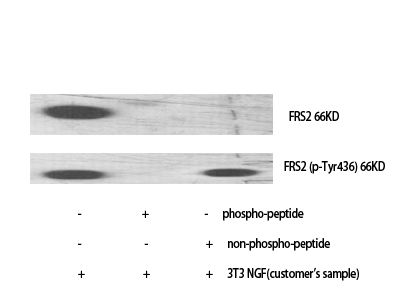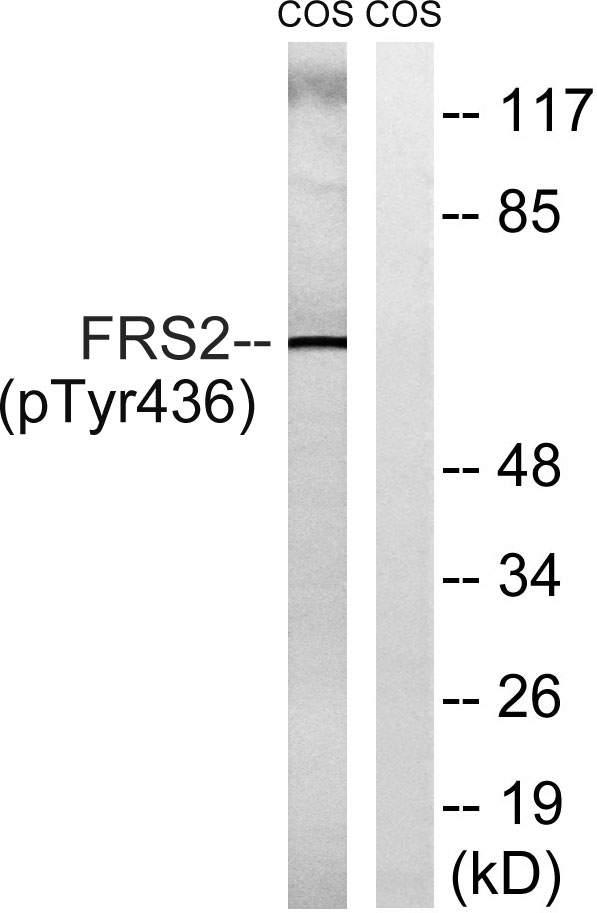FRS2 (phospho Tyr436) Polyclonal Antibody
- Catalog No.:YP0805
- Applications:WB;IHC;IF;ELISA
- Reactivity:Human;Mouse;Monkey
- Target:
- FRS2
- Fields:
- >>Thermogenesis;>>Neurotrophin signaling pathway;>>Proteoglycans in cancer
- Gene Name:
- FRS2
- Protein Name:
- Fibroblast growth factor receptor substrate 2
- Human Gene Id:
- 10818
- Human Swiss Prot No:
- Q8WU20
- Mouse Gene Id:
- 327826
- Mouse Swiss Prot No:
- Q8C180
- Immunogen:
- The antiserum was produced against synthesized peptide derived from human FRS2 around the phosphorylation site of Tyr436. AA range:402-451
- Specificity:
- Phospho-FRS2 (Y436) Polyclonal Antibody detects endogenous levels of FRS2 protein only when phosphorylated at Y436.
- Formulation:
- Liquid in PBS containing 50% glycerol, 0.5% BSA and 0.02% sodium azide.
- Source:
- Polyclonal, Rabbit,IgG
- Dilution:
- WB 1:500 - 1:2000. IHC 1:100 - 1:300. ELISA: 1:10000.. IF 1:50-200
- Purification:
- The antibody was affinity-purified from rabbit antiserum by affinity-chromatography using epitope-specific immunogen.
- Concentration:
- 1 mg/ml
- Storage Stability:
- -15°C to -25°C/1 year(Do not lower than -25°C)
- Other Name:
- FRS2;Fibroblast growth factor receptor substrate 2;FGFR substrate 2;FGFR-signaling adaptor SNT;Suc1-associated neurotrophic factor target 1;SNT-1
- Observed Band(KD):
- 65kD
- Background:
- function:Adapter protein that links FGR and NGF receptors to downstream signaling pathways. Involved in the activation of MAP kinases. Modulates signaling via SHC1 by competing for a common binding site on NTRK1.,PTM:Phosphorylated on tyrosine residues upon stimulation by NGF.,PTM:Ubiquitinated when tyrosine phosphorylated and in a complex with GRB2. The unphosphorylated form is not subject to ubiquitination.,sequence caution:Translated as stop.,similarity:Contains 1 IRS-type PTB domain.,subcellular location:Cytoplasmic, membrane-bound.,subunit:Part of a complex containing FRS2, GRB2 and SOS1. Part of a complex containing GRB2 and CBL. Binds RET (By similarity). Binds FGFR1, SUC1, NTRK1, NTRK2, NTRK3 and SRC. The tyrosine-phosphorylated protein binds the SH2 domains of GRB2 and PTPN11.,tissue specificity:Highly expressed in heart, brain, spleen, lung, liver, skeletal muscle, kidney and testis.,
- Function:
- function:Adapter protein that links FGR and NGF receptors to downstream signaling pathways. Involved in the activation of MAP kinases. Modulates signaling via SHC1 by competing for a common binding site on NTRK1.,PTM:Phosphorylated on tyrosine residues upon stimulation by NGF.,PTM:Ubiquitinated when tyrosine phosphorylated and in a complex with GRB2. The unphosphorylated form is not subject to ubiquitination.,sequence caution:Translated as stop.,similarity:Contains 1 IRS-type PTB domain.,subcellular location:Cytoplasmic, membrane-bound.,subunit:Part of a complex containing FRS2, GRB2 and SOS1. Part of a complex containing GRB2 and CBL. Binds RET (By similarity). Binds FGFR1, SUC1, NTRK1, NTRK2, NTRK3 and SRC. The tyrosine-phosphorylated protein binds the SH2 domains of GRB2 and PTPN11.,tissue specificity:Highly expressed in heart, brain, spleen, lung, liver, skeletal muscle, kidney and t
- Subcellular Location:
- Endomembrane system. Cytoplasmic, membrane-bound.
- Expression:
- Highly expressed in heart, brain, spleen, lung, liver, skeletal muscle, kidney and testis.
Refined-JinQi-JiangTang tablet ameliorates hypertension through activation of FGF21/FGFR1 axis in fructose-fed rats WB Rat liver /
The Hypoglycemic Effect of JinQi Jiangtang Tablets Is Partially Dependent on the Palmatine-Induced Activation of the Fibroblast Growth Factor Receptor 1 Signaling Pathway Frontiers in Pharmacology Yubin Ji WB Mouse,Human
Sympathetic Neurotransmitter, VIP, Delays Intervertebral Disc Degeneration via FGF18/FGFR2-Mediated Activation of Akt Signaling Pathway Advanced Biology Kaiqiang Sun WB,IHC Human,Mouse lumbar spine nucleus pulposus (NP) cell
- June 19-2018
- WESTERN IMMUNOBLOTTING PROTOCOL
- June 19-2018
- IMMUNOHISTOCHEMISTRY-PARAFFIN PROTOCOL
- June 19-2018
- IMMUNOFLUORESCENCE PROTOCOL
- September 08-2020
- FLOW-CYTOMEYRT-PROTOCOL
- May 20-2022
- Cell-Based ELISA│解您多样本WB检测之困扰
- July 13-2018
- CELL-BASED-ELISA-PROTOCOL-FOR-ACETYL-PROTEIN
- July 13-2018
- CELL-BASED-ELISA-PROTOCOL-FOR-PHOSPHO-PROTEIN
- July 13-2018
- Antibody-FAQs
- Products Images

- Western Blot analysis of various cells using Phospho-FRS2 (Y436) Polyclonal Antibody
.jpg)
- Western Blot analysis of COS cells using Phospho-FRS2 (Y436) Polyclonal Antibody

- Immunohistochemistry analysis of paraffin-embedded human brain, using FRS2 (Phospho-Tyr436) Antibody. The picture on the right is blocked with the phospho peptide.

- Western blot analysis of lysates from COS7 cells , using FRS2 (Phospho-Tyr436) Antibody. The lane on the right is blocked with the phospho peptide.



